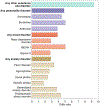Deconstructing the neurobiology of cannabis use disorder
- PMID: 32251385
- PMCID: PMC9484812
- DOI: 10.1038/s41593-020-0611-0
Deconstructing the neurobiology of cannabis use disorder
Abstract
There have been dramatic changes worldwide in the attitudes toward and consumption of recreational and medical cannabis. Cannabinoid receptors, which mediate the actions of cannabis, are abundantly expressed in brain regions known to mediate neural processes underlying reward, cognition, emotional regulation and stress responsivity relevant to addiction vulnerability. Despite debates regarding potential pathological consequences of cannabis use, cannabis use disorder is a clinical diagnosis with high prevalence in the general population and that often has its genesis in adolescence and in vulnerable individuals associated with psychiatric comorbidity, genetic and environmental factors. Integrated information from human and animal studies is beginning to expand insights regarding neurobiological systems associated with cannabis use disorder, which often share common neural characteristics with other substance use disorders, that could inform prevention and treatment strategies.
Conflict of interest statement
Competing interests
The authors declare no competing interests.
Figures






Similar articles
-
Adolescent brain maturation, the endogenous cannabinoid system and the neurobiology of cannabis-induced schizophrenia.Prog Neurobiol. 2010 Nov;92(3):370-85. doi: 10.1016/j.pneurobio.2010.06.010. Epub 2010 Jul 16. Prog Neurobiol. 2010. PMID: 20624444 Review.
-
Cannabis use disorder: from neurobiology to treatment.J Clin Invest. 2024 Oct 15;134(20):e172887. doi: 10.1172/JCI172887. J Clin Invest. 2024. PMID: 39403927 Free PMC article. Review.
-
Neurobiology of cannabis addiction.Indian J Physiol Pharmacol. 2008 Jul-Sep;52(3):217-32. Indian J Physiol Pharmacol. 2008. PMID: 19552052 Review.
-
fMRI study of neural sensitization to hedonic stimuli in long-term, daily cannabis users.Hum Brain Mapp. 2016 Oct;37(10):3431-43. doi: 10.1002/hbm.23250. Epub 2016 May 11. Hum Brain Mapp. 2016. PMID: 27168331 Free PMC article.
-
New vistas on cannabis use disorder.Neuropharmacology. 2017 Sep 15;124:62-72. doi: 10.1016/j.neuropharm.2017.03.033. Epub 2017 Mar 31. Neuropharmacology. 2017. PMID: 28373077 Free PMC article. Review.
Cited by
-
Cannabinoid Modulation of Dopamine Release During Motivation, Periodic Reinforcement, Exploratory Behavior, Habit Formation, and Attention.Front Synaptic Neurosci. 2021 Jun 10;13:660218. doi: 10.3389/fnsyn.2021.660218. eCollection 2021. Front Synaptic Neurosci. 2021. PMID: 34177546 Free PMC article. Review.
-
Gender Differences in Dual Diagnoses Associated with Cannabis Use: A Review.Brain Sci. 2022 Mar 15;12(3):388. doi: 10.3390/brainsci12030388. Brain Sci. 2022. PMID: 35326345 Free PMC article. Review.
-
The Developmental Trajectory to Cannabis Use Disorder.Am J Psychiatry. 2024 May 1;181(5):353-358. doi: 10.1176/appi.ajp.20231006. Am J Psychiatry. 2024. PMID: 38706340 Free PMC article.
-
Cannabis use among Arab students: a systematic review.Front Psychiatry. 2025 Jul 10;16:1511563. doi: 10.3389/fpsyt.2025.1511563. eCollection 2025. Front Psychiatry. 2025. PMID: 40708594 Free PMC article.
-
Neural basis of adolescent THC-induced potentiation of opioid responses later in life.Neuropsychopharmacology. 2025 Apr;50(5):818-827. doi: 10.1038/s41386-024-02033-8. Epub 2024 Dec 10. Neuropsychopharmacology. 2025. PMID: 39658631 Free PMC article.
References
-
- UN Office on Drugs and Crime World Drug Report 3: Market Analysis of Plant-Based Drugs: Opiates, Cocaine, Cannabis. (UNODC Research, 2017).
-
- Kerridge BT et al. Changes in the prevalence and correlates of cocaine use and cocaine use disorder in the United States, 2001–2002 and 2012–2013. Addict. Behav 90, 250–257 (2019). - PubMed
-
- Nutt DJ, King LA & Phillips LD; Independent Scientific Committee on Drugs. Drug harms in the UK: a multicriteria decision analysis. Lancet 376, 1558–1565 (2010). - PubMed
Publication types
MeSH terms
Grants and funding
LinkOut - more resources
Full Text Sources
Other Literature Sources
Medical

